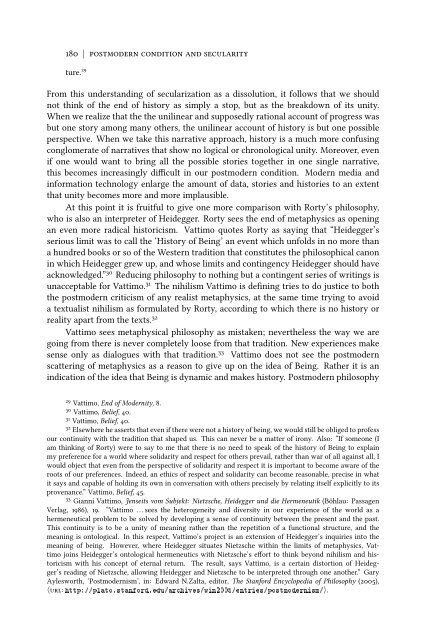Secularization as Kenosis
Secularization as Kenosis
Secularization as Kenosis
Create successful ePaper yourself
Turn your PDF publications into a flip-book with our unique Google optimized e-Paper software.
180 | postmodern condition and secularity<br />
ture. 29<br />
From this understanding of secularization <strong>as</strong> a dissolution, it follows that we should<br />
not think of the end of history <strong>as</strong> simply a stop, but <strong>as</strong> the breakdown of its unity.<br />
When we realize that the the unilinear and supposedly rational account of progress w<strong>as</strong><br />
but one story among many others, the unilinear account of history is but one possible<br />
perspective. When we take this narrative approach, history is a much more confusing<br />
conglomerate of narratives that show no logical or chronological unity. Moreover, even<br />
if one would want to bring all the possible stories together in one single narrative,<br />
this becomes incre<strong>as</strong>ingly difficult in our postmodern condition. Modern media and<br />
information technology enlarge the amount of data, stories and histories to an extent<br />
that unity becomes more and more implausible.<br />
At this point it is fruitful to give one more comparison with Rorty’s philosophy,<br />
who is also an interpreter of Heidegger. Rorty sees the end of metaphysics <strong>as</strong> opening<br />
an even more radical historicism. Vattimo quotes Rorty <strong>as</strong> saying that “Heidegger’s<br />
serious limit w<strong>as</strong> to call the ‘History of Being’ an event which unfolds in no more than<br />
a hundred books or so of the Western tradition that constitutes the philosophical canon<br />
in which Heidegger grew up, and whose limits and contingency Heidegger should have<br />
acknowledged.” 30 Reducing philosophy to nothing but a contingent series of writings is<br />
unacceptable for Vattimo. 31 The nihilism Vattimo is defining tries to do justice to both<br />
the postmodern criticism of any realist metaphysics, at the same time trying to avoid<br />
a textualist nihilism <strong>as</strong> formulated by Rorty, according to which there is no history or<br />
reality apart from the texts. 32<br />
Vattimo sees metaphysical philosophy <strong>as</strong> mistaken; nevertheless the way we are<br />
going from there is never completely loose from that tradition. New experiences make<br />
sense only <strong>as</strong> dialogues with that tradition. 33 Vattimo does not see the postmodern<br />
scattering of metaphysics <strong>as</strong> a re<strong>as</strong>on to give up on the idea of Being. Rather it is an<br />
indication of the idea that Being is dynamic and makes history. Postmodern philosophy<br />
29 Vattimo, End of Modernity, 8.<br />
30 Vattimo, Belief, 40.<br />
31 Vattimo, Belief, 40.<br />
32 Elsewhere he <strong>as</strong>serts that even if there were not a history of being, we would still be obliged to profess<br />
our continuity with the tradition that shaped us. This can never be a matter of irony. Also: “If someone (I<br />
am thinking of Rorty) were to say to me that there is no need to speak of the history of Being to explain<br />
my preference for a world where solidarity and respect for others prevail, rather than war of all against all, I<br />
would object that even from the perspective of solidarity and respect it is important to become aware of the<br />
roots of our preferences. Indeed, an ethics of respect and solidarity can become re<strong>as</strong>onable, precise in what<br />
it says and capable of holding its own in conversation with others precisely by relating itself explicitly to its<br />
provenance.” Vattimo, Belief, 45.<br />
33 Gianni Vattimo, Jenseits vom Subjekt: Nietzsche, Heidegger und die Hermeneutik (Böhlau: P<strong>as</strong>sagen<br />
Verlag, 1986), 19. “Vattimo . . . sees the heterogeneity and diversity in our experience of the world <strong>as</strong> a<br />
hermeneutical problem to be solved by developing a sense of continuity between the present and the p<strong>as</strong>t.<br />
This continuity is to be a unity of meaning rather than the repetition of a functional structure, and the<br />
meaning is ontological. In this respect, Vattimo’s project is an extension of Heidegger’s inquiries into the<br />
meaning of being. However, where Heidegger situates Nietzsche within the limits of metaphysics, Vattimo<br />
joins Heidegger’s ontological hermeneutics with Nietzsche’s effort to think beyond nihilism and historicism<br />
with his concept of eternal return. The result, says Vattimo, is a certain distortion of Heidegger’s<br />
reading of Nietzsche, allowing Heidegger and Nietzsche to be interpreted through one another.” Gary<br />
Aylesworth, ‘Postmodernism’, in: Edward N.Zalta, editor, The Stanford Encyclopedia of Philosophy (2005),<br />
〈url: �����������������������������������������������������������������〉.










